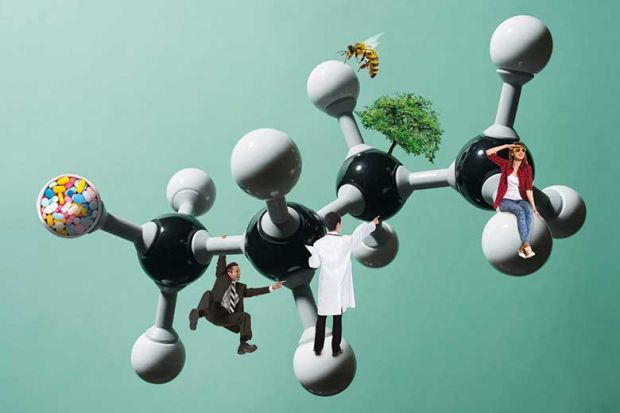The United Nations has designated 2019 the international year of the periodic table of the elements, in recognition of the 150th anniversary of the table’s creation by the Russian chemist Dmitry Mendeleev.
But while chemists around the world welcome the public prominence that this will give to their discipline, there is also some debate about what the modern incarnation of that discipline actually is.
When last year’s Nobel Prize in Chemistry went to three researchers who – as the press release put it – took “control of evolution” to produce certain enzymes and antibodies used in medical applications, some chemists welcomed the acknowledgment of the enormous breadth and importance of their subject. But others groaned that, once again, “their” turn in the media limelight had been stolen by “biologists”.
Meanwhile, the fact that only five women have ever won a Nobel Prize in Chemistry illustrates that the discipline’s senior levels continue to be largely male dominated. And while student demand for the subject appears to be solid for now, history suggests that it is characterised by volatility. Just before Christmas, Bangor University announced proposals to close its chemistry department.
So what is the current state of academic chemistry? Seven academics analyse the admixture.

‘The “central science” will always be subject to reconfiguration’
The high cost of teaching chemistry, requiring cross-subsidy from other subjects, is always going to make it vulnerable to universities looking to make cuts. A little over a decade ago, the picture in that regard looked bleak. A drop in applications led to the closure of 26 chemistry departments around the UK. Some observers predicted that there would be only six departments left by 2014.
Fast-forward to 2019, however, and the outlook has changed. The data show that demand for chemistry degrees is holding steady or rising in the UK – as well as in the US and Australia – while about a third of the UK departments that closed have reopened. However, chemistry education – like higher education in general – is more than ever a business, meaning that any downturn in student numbers could soon see the positive trend reversed again. Bangor University’s proposal to shut its chemistry department is an illustration of that.
An equally irreversible trend is the bureaucratisation of university management structures, requiring faculty to contend with an ever-growing number of administrators. This is not unique to chemistry, of course, but chemists feel that it affects them in specific ways. Every so often, for instance, there is pressure from above to decrease the amount of expensive time that students spend in teaching laboratories – perhaps replacing it with time in virtual labs.
Such ideas have usually been abandoned quickly when is it pointed out that lab experience is a requirement for degree accreditation by professional bodies. That said, the increasing quality of offerings such as Labster’s virtual reality lab simulations and Microsoft’s augmented reality HoloLens is such that technology will, I believe, soon be usefully “disrupting” the classroom. Educational apps and games are also increasingly popular; examples in organic chemistry include “Chairs!”, “Backside Attack”, “Mechanisms” and “Chirality-2” (the last of which I helped to develop).
Changing properties: chemistry in the US and the UK
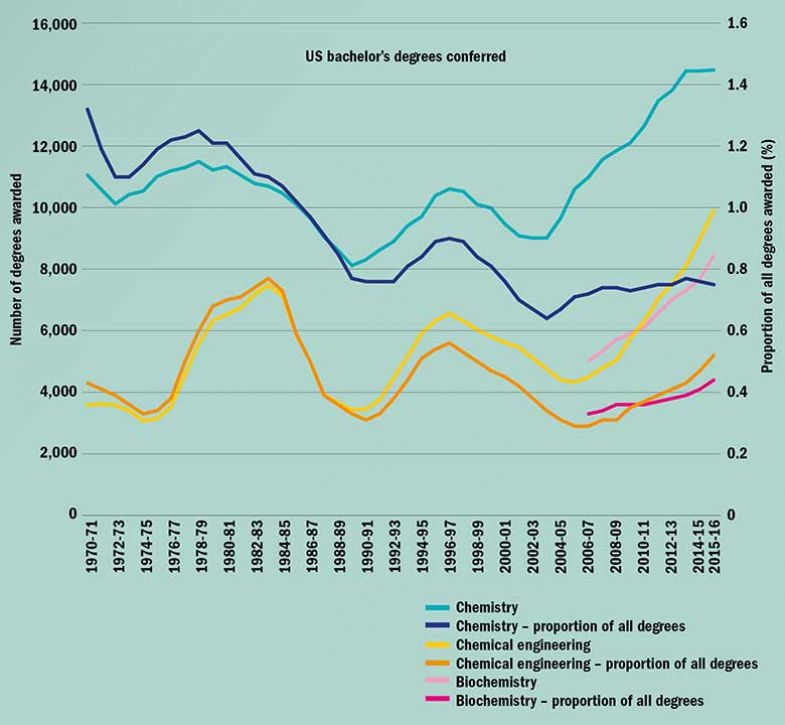
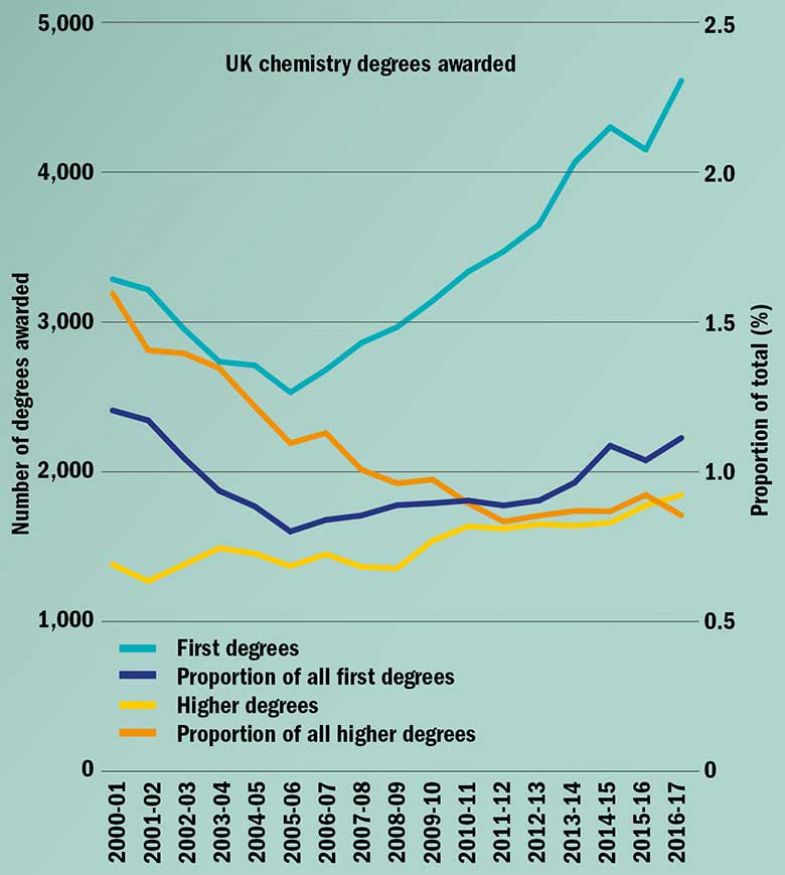
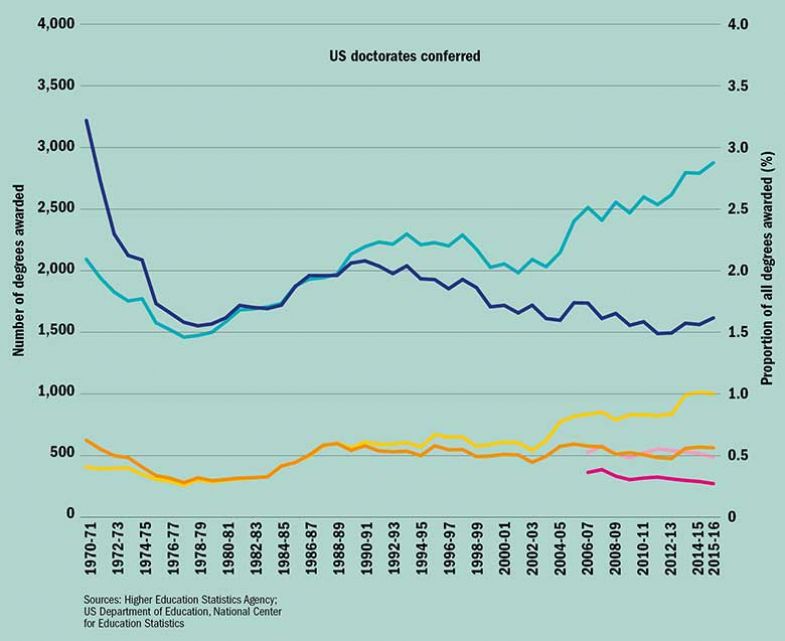
In the postgraduate world, chemistry, like many subjects, produces far more doctorates than are needed to fill vacant academic positions. This has resulted in a trend for casual academic contracts. Getting a permanent position is made all
the more difficult by the fact that research funding levels generally wax and wane with the economy, so – in Australia, at least – they are presently shrinking. This has led to a focus on getting more chemistry PhD holders working with industry. Fortunately, a search of the job ads shows that there are many opportunities.
Key areas of both academic and commercial research include energy and environment, advanced materials and drugs. Don’t fancy the lab? No problem. Computational chemists use supercomputers to predict the properties and behaviours of molecules before they are made.
But research into all these things is increasingly carried out by large, multidisciplinary teams rather than lone wolves. Universities have responded to this by increasing the amount of group work throughout most undergraduate degrees. And while postgraduate research projects must, by their (current) nature, be the result of individual effort, there is a push to ensure that postgrads gain some form of industry experience during their studies. Such placements are not yet a formal requirement, but they seem likely to become more popular.
So, despite the challenges, I believe 2019 is an exciting time to be a chemist. Even if it is not always immediately obvious, our subject underpins many areas of technology and holds the key to solving numerous problems that affect people deeply. Like the complex molecules that it studies, the “central science” will always be subject to reconfiguration, but life would be impossible without it.
Oliver A. H. Jones is an associate professor of chemistry at RMIT University in Melbourne.
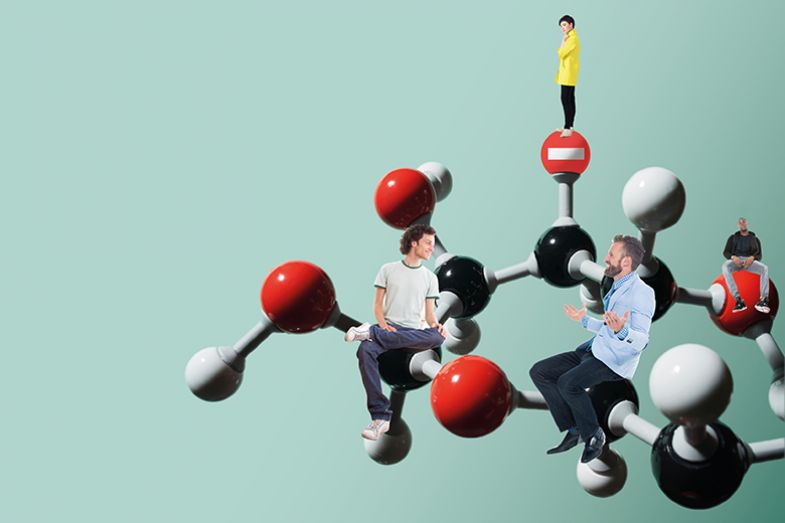
‘I see little value in determining who is and is not a chemist’
The periodic table was developed to help chemistry practitioners understand their surroundings and make predictions about chemical systems. The field of chemistry itself, however, is less well defined.
I think of it as the study of interactions of matter on the scale of the atom. Properties of matter smaller than the atom are generally of interest to physicists, while biology is the study of systems whose functions are determined by large collections of molecules, serving an almost mechanical purpose.
However, there is large overlap because chemical interactions are governed by density of electrons (subatomic particles), while biological systems are just very complicated chemical systems. And while chemists may think of themselves as atom manipulators, the underlying objective for all chemists is to enable an understanding of larger, more complicated chemical systems.
To do so, the field has had to expand beyond “molecule makers” – synthetic chemists – to include scientists advancing chemistry in the directions of biology, instrumentation (allowing for the characterisation of chemical systems) and theory (enabling predictions of chemical systems). There is now room in the discipline to accommodate people with backgrounds in computer science, engineering, biology, psychology and beyond.
I see little value in determining who is and is not a chemist based on the field in which they work. We do not need to draw smaller and smaller circles of academic identification: the beauty of chemistry is that the topic is inherently broad. Indeed, it is that combination of expertise that is enabling chemistry to drive countless exciting developments, from new battery materials to selective anticancer drugs and imaging technologies with increased resolution.
The advances will keep coming only if we can continue to attract bright minds to chemistry. But history has taught us that even the least sexy flavour of chemistry can be made more attractive if properly contextualised. Around the mid-2000s, analytical chemistry was repackaged as “forensic chemistry”, partially driven by the emergence of crime-based television dramas. As a result, even I once considered becoming a forensic chemist – but I was not ready for a life of serial -dilutions.
A similar renaissance occurred for organic chemists – the emergence of medicinal chemistry. Perhaps these rebrands were driven by the availability of industry jobs, or maybe it was motivated by an increase in undergraduate admissions. But it turns out that it does not really matter what platform captures the next wave of chemists, because once students learn the basic chemical concepts, they realise that they can apply them to a multitude of problems.
Did Mendeleev know that he was laying the foundations for what would become “forensic chemistry”? Probably not. But all forensic chemists still look back to an incarnation of the periodic table: a symbol of clarity and the enduring keystone in our discipline.
Christopher H. Hendon is assistant professor of computational materials chemistry at the University of Oregon.
‘Those women coming after me still have the same struggles’
When I began graduate school at Cornell University 20 years ago, I was by no means naive about my future. With just two women on the faculty, I knew that my aspiration to become a chemistry professor at a research-intensive university was ambitious. I knew that significant barriers lay ahead. Looking back now, though, I realise that I was really naive about one thing: I assumed that my struggles would be harder than the struggles of those who came after me.
Although I had seen some of the data on gender disparities in hiring, grant funding and publications, my jaw literally dropped when, earlier this year, I read Kathleen Grogan’s comprehensive summary of all relevant studies, which elucidated the full extent of white male privilege in science. Her article, “How the entire scientific community can confront gender bias in the workplace”, published in Nature Ecology & Evolution, reveals that women are less likely to receive “excellent” letters of recommendation, to be employed in labs with male principal investigators, to have grant renewals funded and to have their manuscripts accepted by all-male panels of reviewers. The effects of all these inequities are often cumulative, serving to widen the gender gap at every professional step. How can we still be OK with such systemic inequalities?
At the early-career level, only 37 per cent of US chemistry PhDs are awarded to women, even though women are 51 per cent of the general population. African Americans, Native Americans and Hispanics receive only 11 per cent, even though, combined, they make up 33 per cent of the population. The numbers drop even lower if you sample the -professoriate.
We need everyone – institutions, academics, funders, publishers, professional societies – to take a serious look at their own data. They must reflect on the practices that led them to where they are, and on how those could be reformed to help equalise opportunities.
Exemplary cases should be studied and imitated (with appropriate adjustments). One case is my own department at the University of Michigan. In 2002 (before I arrived), its faculty consisted of 12 per cent women and 2 per cent people from historically under-represented backgrounds. Those figures have risen to 33 per cent and 11 per cent, respectively.
Leaky pipelines: Women in chemistry

These remarkable gains could not have occurred without widespread acceptance that there was a problem, a commitment by everyone to learn and grow, and time to implement strategies (fuelled by an Advance grant from the National Science Foundation) to create a culture that is supportive of and invested in all faculty. Initiatives include improving hiring practices (including mandatory unconscious bias training for everyone on hiring committees), better junior faculty mentoring and more transparent policies and decision-making bodies.
Consistent with the literature showing that more diverse teams produce better, more creative science, it is likely no coincidence that the department’s national rankings increased from 21 to 15 during this same time period. Moreover, our graduate population exceeds the national average for female representation in chemistry; last year, our incoming class was 45 per cent female, with 15 per cent of students from historically under-represented groups.
But there is still much to do. Recognising that patches can serve an important short-term role in minimising the systemic gaps, I recently started a website called DiversifyChemistry.com. The goal is to bring visibility to people from historically under-represented backgrounds, and is based on similar sites in psychology and ecology and evolutionary biology. Its database can be used as a resource for hiring, selecting speakers and seeking reviewers, journalist sources or awards nominees; studies have shown that more diverse groups are generated when working from a list as opposed to relying on memory.
Some critics are sceptical that a site that actively excludes heterosexual, able-bodied Caucasian males could foster inclusivity. But Brian McGill from the University of Maine’s School of Biology and Ecology put it best on the Dynamic Ecology blog: “Once you acknowledge inequality of outcomes, you either have to acknowledge net inequality of opportunity, or net inequality of ability, and I’m going to go with the first choice!”
The day that all people are equally represented, supported, mentored and honoured in chemistry is the day that efforts such as Diversify-Chemistry can be discontinued. My hope is that we will all work together to hasten that day.
Anne J. McNeil is the Arthur F. Thurnau professor of chemistry and a Howard Hughes Medical Institute professor at the University of Michigan.
‘Universities are increasingly valuing interdisciplinary chemistry research’
Recent years have seen raging debate about what constitutes “chemistry” – particularly in light of the fact that half the Nobel prizes for the subject have been awarded to the life sciences over the past decade.
So what is the answer? The Merriam-Webster dictionary defines chemistry simply as “a science that deals with the composition, structure, and properties of substances and with the transformations that they undergo”. However, the same can be said of physics, materials science, much of life sciences and other sister disciplines to chemistry. In addition, the boundaries between chemistry and these disciplines are increasingly blurred. Where should the line be drawn, for instance, between chemical biology and biological chemistry? Or between physical chemistry and chemical physics? And why aren’t the substantial contributions of chemistry to molecular biology and biophysics acknowledged in the names of those disciplines?
My own educational and professional trajectory serves as an example of how interdisciplinary the study and application of chemistry has become. Unable to decide between chemistry and mathematics, I pursued a master’s in natural sciences. I followed this with a PhD in computational organic chemistry, and postdoctoral training in computational structural biology and computational biophysics. I started my own research group in a department of cell and molecular biology, nominally (but not in reality) as far from chemistry as it is possible to go within science, only to later return to my roots, becoming a professor of structural biology in the biochemistry division of a chemistry department.
Unsurprisingly, my research sits at the interface between chemistry, biology, physics and computer science, using computational tools based on the principles of chemical physics to understand the chemical basis for how proteins evolve, with the aim of applying these insights to the creation of designer proteins for a range of applications from bioremediation to novel biotherapeutics. I achieve this through the joint effort of an amazing group of researchers, with a broad range of backgrounds: I have worked with theoretical physicists, organic chemists, structural biologists, evolutionary biologists, computer scientists and, more recently, even materials scientists, to name but a few.
Interdisciplinarity, of course, comes at a price: as the saying goes, “Jack of all trades, master of none.” However, it allows you to see the bigger scientific picture and to make unexpected connections. Modern scientific challenges often require contributions from a wide range of different areas of expertise; both generalists and specialists bring important skills, and both should be valued. Fortunately, an increasing number of universities are appreciating the value of interdisciplinarity in chemistry research, including offering a range of interdisciplinary chemistry programmes and tracks that greatly broaden the horizons of students entering our discipline.
The Royal Society of Chemistry recently raised concerns about a declining number of chemistry undergraduates in the UK, despite a greater number of young people studying the subject at A level. But there are many paths to becoming a practising chemist, given all those other subjects well beyond chemistry’s traditional boundaries that its techniques now underpin. Perhaps it is time to reclaim the term “chemistry” for all of these. Either way, chemists should celebrate and embrace the breadth of our discipline, and harness it to solve the grand challenges of tomorrow.
Lynn Kamerlin is professor of structural biology at Uppsala University.
‘Nearly three-quarters of academic chemical researchers work in Russell Group universities’
Research assessment profoundly changed the shape of chemistry research in the UK university system in a relatively short time. Between the 1992 research assessment exercise and the 2014 research excellence framework, the number of higher education institutions claiming to be active in chemical research fell from 66 to 37. Yet despite this drastic reduction, the number of academic chemists recorded as actively involved in research fell by less than 10 per cent.
The Russell Group universities were the only beneficiaries. Two of the 23 current member institutions that made a chemistry submission to the 1992 RAE discontinued chemical research – King’s College London and the University of Exeter. In the remainder, academic staff numbers increased, by 18 per cent: 138 people. By contrast, the former polytechnics were the big losers. In 1992, the year they were granted university status, 17 entered; by 2014, there were only two.
The funding councils had initially seemed willing to help the neo-universities grow their research, with the Higher Education Funding Council for England providing an annual £16 million for that purpose. But Robert May (now Lord May of Oxford), chief scientific adviser to the UK government between 1995 and 2000, was explicit that better quality and improved value for money would result if the numbers of chemistry (and physics) departments were halved. And, after the 2001 RAE, Hefce awarded only nominal funding to departments rated 3a (defined as those in which more than two-thirds of the research submitted was deemed to reach standards of “national excellence’’). This signed many death warrants.
Meanwhile, those departments achieving the top, five-star rating saw a significant increase in their research block grants. Most also benefited substantially from significantly increased infrastructure funding arising out of 1997’s Dearing report, and that continues to this day; the University of Oxford built a new chemical laboratory capable of housing 440 researchers, for instance.
High concentration: chemistry’s elite profile
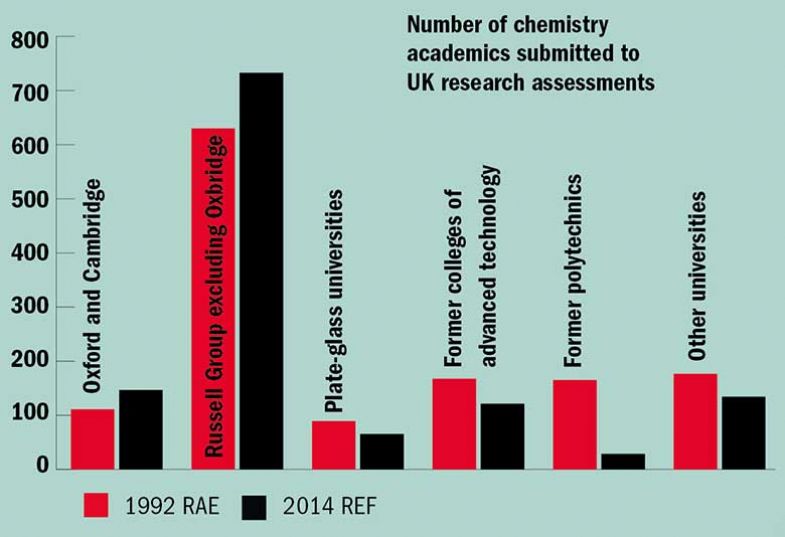
The result is that the 2008 RAE and the 2014 REF both painted a picture of a stable and successful chemistry research community, with significant numbers of early career researchers, improved international impact and good sustainability. Although the environment remains competitive, perhaps even pressurised, the febrile atmosphere of the early years of the millennium seemed to have been left behind. King’s even reopened its chemistry department in 2011, offering an undergraduate course, chemistry with biomedicine (although it did not make a submission to the REF’s chemistry panel in 2014).
Two issues are of concern to me, however: gender balance and access for economically disadvantaged students. A recent report for the Royal Society of Chemistry, Breaking the Barriers, shows that while gender balance is good at undergraduate level, it deteriorates with seniority. Just 9 per cent of UK professors of chemistry are women, and I am unconvinced that there is the required commitment within the community to redress that. But at least gender imbalance is receiving attention.
The access issues receive less attention, but they are just as important. As a result of the research concentration discussed above, more than 70 per cent of academic chemical researchers work in Russell Group universities, with 12 per cent in Oxford or Cambridge. Whatever the reasons, it is now beyond statistical dispute that private school students are heavily over--represented among undergraduates at these universities. Increasing recruitment competition will probably exacerbate this situation – witness the recently proposed closure of chemistry at non-Russell Group member Bangor University. The result is that many young people who could become excellent chemists will never study this most dynamic and beautiful of the sciences.
Richard Joyner is emeritus professor of chemistry at Nottingham Trent University, where he was dean of research from 1994 to 2004. He has occupied chairs of chemistry at two Russell Group universities, as well as serving for 10 years as chair of the pressure group Save British Science.
‘Chemists may be their own worst enemies in failing to promote the wonder and importance of their subject’
Chemistry has been reinventing itself for more than 200 years, and it remains a dynamic and exciting but largely misunderstood subject.
The impact of the subject on everyday life has never been greater. Paints, fuels, oils, LED screens, lithium batteries, drugs, electronic components and a thousand other innovations all rely on contemporary chemistry. This explains why, according to the UK government’s recent impact report on the effect of Brexit, the chemical industry accounts for more than £12 billion of the UK economy’s gross value added and nearly 100,000 direct jobs.
Yet for many of the public, interest in chemistry is limited to answering TV quiz questions about the periodic table or (much worse) complaining about the polluting effects of chemicals.
Other branches of science fare better in this regard, and it is true that quantum computing, Fermat’s last theorem or investigating the human genome can sound, to the untrained ear, much more mysterious and compelling than improving the energy efficiency of caustic soda production, or devising a more efficient desal-ination method. But chemists may also be their own worst enemies in failing to promote the wonder and importance of their subject as assertively as physicists, mathematicians and life scientists do.
In reality, the distinctions between chemistry and other areas of science are very diffuse, not least because chemistry has influenced so many other subjects. But this breadth may also be part of the explanation for chemistry’s identity crisis, as other subjects have laid claim to its kudos. Polymers and organic light-emitting diodes are claimed by materials scientists. Drug discovery (still very much the domain of pharmaceutical chemists) is somehow lost in the big molecule world of life sciences. Quantum chemistry is ruthlessly rebadged as quantum science.
The fundamentals of chemistry remain challenging and fascinating, however, and I would argue that the world needs the subject now more than ever. The poor old chemist may be characterised as an environmental menace, but many of the greatest challenges facing society depend on chemists’ ability to create new molecules with remarkable properties. Any clean energy solution to climate change, for instance – be it solar, wind, tidal or nuclear – will require all the talents of chemists to improve both energy conversion and storage. And clean processes to deliver higher living standards and to feed and keep healthy an expanding world population will require major advances across a broad sweep of established and new chemical industries and processes, including recycling.
Yet even if chemists deliver these advances, I fear that their achievements will continue to go unsung if they do not proclaim their achievements more loudly and clearly.
J. Derek Woollins is vice-principal for research and innovation and a professor in the School of Chemistry at the University of St Andrews.
‘Efforts to address the slide in UK applications must begin with teachers’
The global publicity surrounding the 150th anniversary of the publication of Mende-leev’s periodic table is very timely in the UK given the recent decline in home student applications to study chemistry at UK universities.
While the decreasing population of 18-year-olds could be partly to blame, this does not explain the severity of the drop – 13 per cent since 2015 – particularly in light of the increase in the number of young people studying chemistry at A level.
The statistics are all the more ominous given the series of closures of chemistry departments that occurred across the UK in the decade leading up to 2005 – when I was at the start of my independent academic career and trying to land a permanent position. Subsequently, however, the situation turned around quite dramatically, with chemistry undergraduate numbers surging over the next 10 years.
Many things contributed to this. One was the additional funding from the now-defunct Higher Education Funding Council for England to support “strategically important and vulnerable” subjects. Another was an increase in outreach activities from the Royal Society of Chemistry – particularly its “Chemistry for Our Future” programme, which, among other things, offered school pupils the chance to visit universities and industries.
Waning interest: UK applications
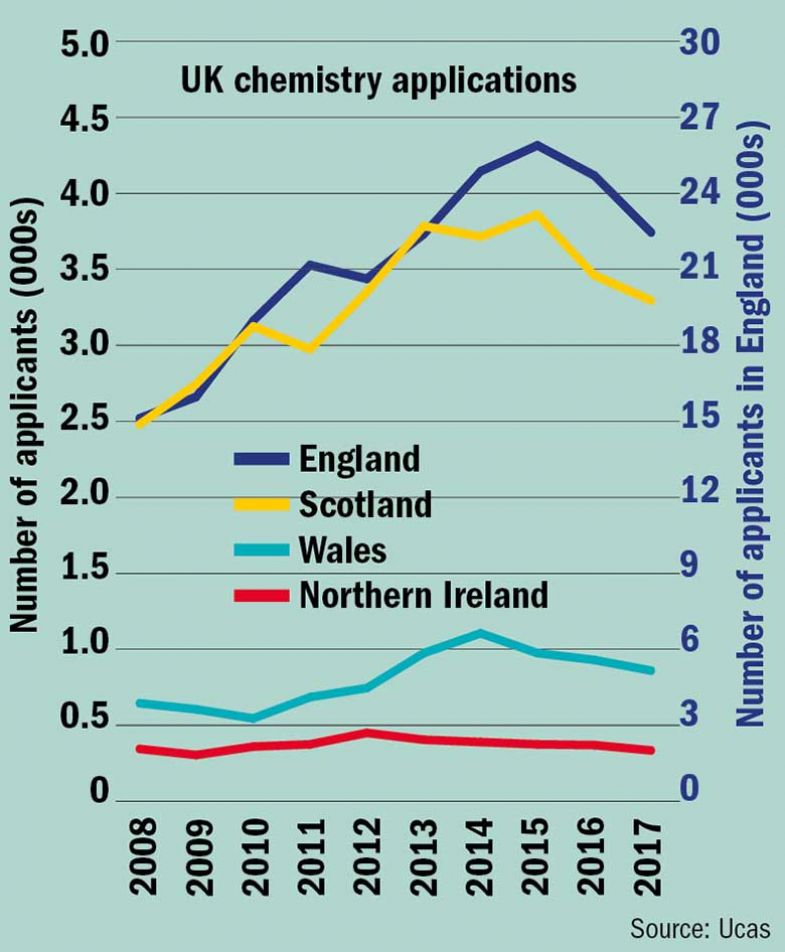
Yet here we are at the start of 2019 with Bangor University launching a consultation on the future of its single-honours chemistry course.
So what has changed? The toughening-up of the chemistry A-level syllabus could be a factor, resulting in chemistry, more than ever, being seen as a “difficult” subject by those who take it up, and discouraging them from continuing it at university. It is also likely that the increased number of places for medicine at university has drawn applicants away, given that those who take A-level chemistry sometimes do so because it is seen as an “enabling” subject for successful medical applications (a chemistry degree sometimes being taken up by unsuccessful applicants as something of a consolation prize). Biology and sports science have also expanded in recent years, potentially to the detriment of chemistry.
Whatever its causes, the slide must be addressed. It is not all down to academics. With a daughter in the first year of A levels in chemistry, biology and mathematics, I can see only too clearly the impact that schoolteachers can have on students’ levels of engagement and excitement with subjects. This is where efforts need to begin to make young people aware that chemistry degrees lead to careers that are rewarding both intrinsically and financially – and that are emphatically not just for men (role models can help in this regard).
UK graduates in chemistry earn upwards of £26,000 six months after graduation, compared with the national average of just over £23,000. And chemistry is essential to addressing many high-profile global and technological challenges, such as improving sustainability (reducing plastic waste and developing energy-efficient and green processes), creating better batteries and combating antibiotic resistance.
My involvement with a Royal Society Summer Exhibition on “smart surfaces” last year gave me a clear indication of the high level of interest that chemistry inspires in schoolchildren when it is presented in an exciting and enthusiastic way. Perhaps now is the time to relaunch some version of Chemistry for Our Future. Either way, though, the university chemistry community needs to give schoolteachers all the help it can if we are to avoid more department closures.
Claire J. Carmalt is professor of inorganic chemistry and head of the department of chemistry at UCL.
POSTSCRIPT:
Print headline: Chemical bonds
Register to continue
Why register?
- Registration is free and only takes a moment
- Once registered, you can read 3 articles a month
- Sign up for our newsletter
Subscribe
Or subscribe for unlimited access to:
- Unlimited access to news, views, insights & reviews
- Digital editions
- Digital access to THE’s university and college rankings analysis
Already registered or a current subscriber? Login
